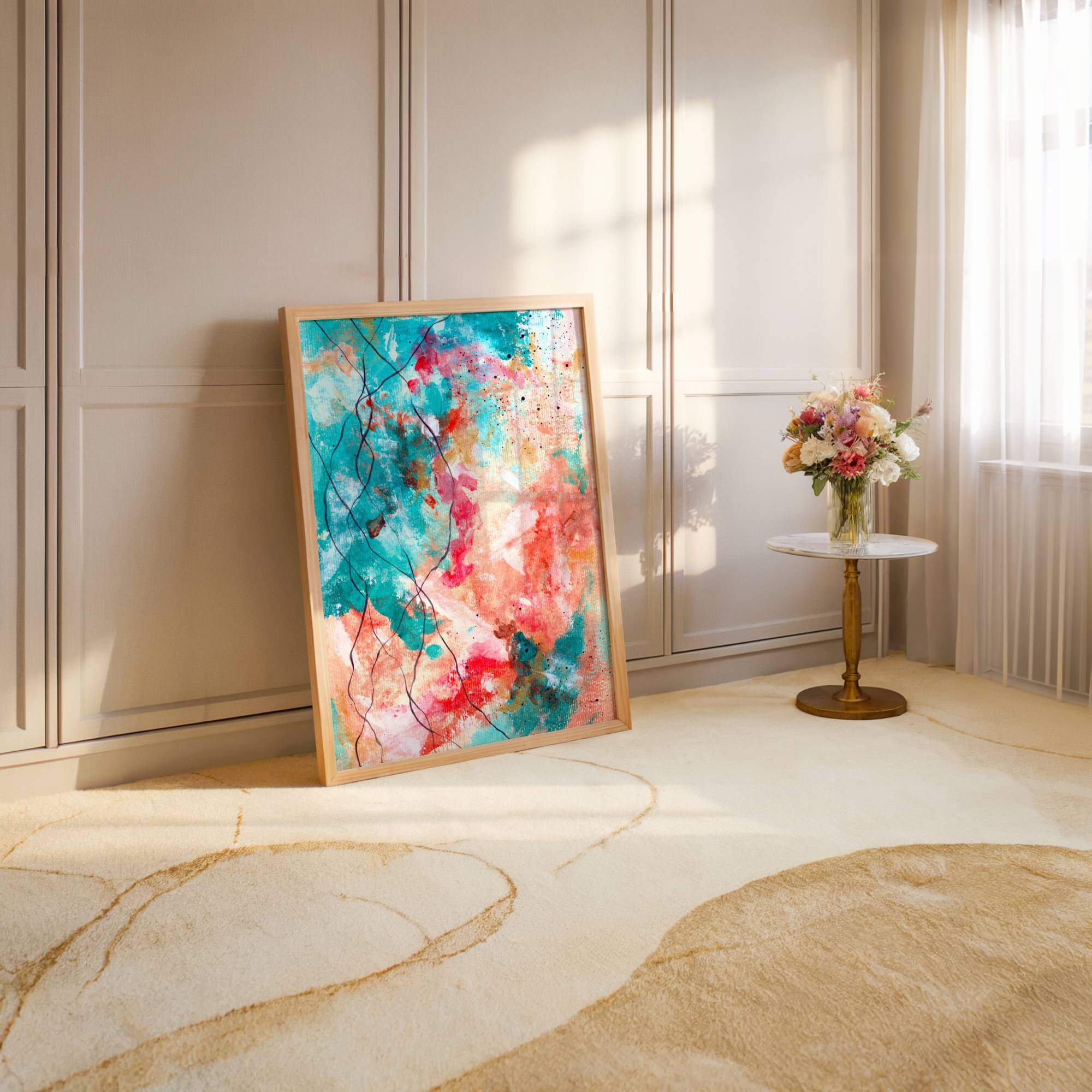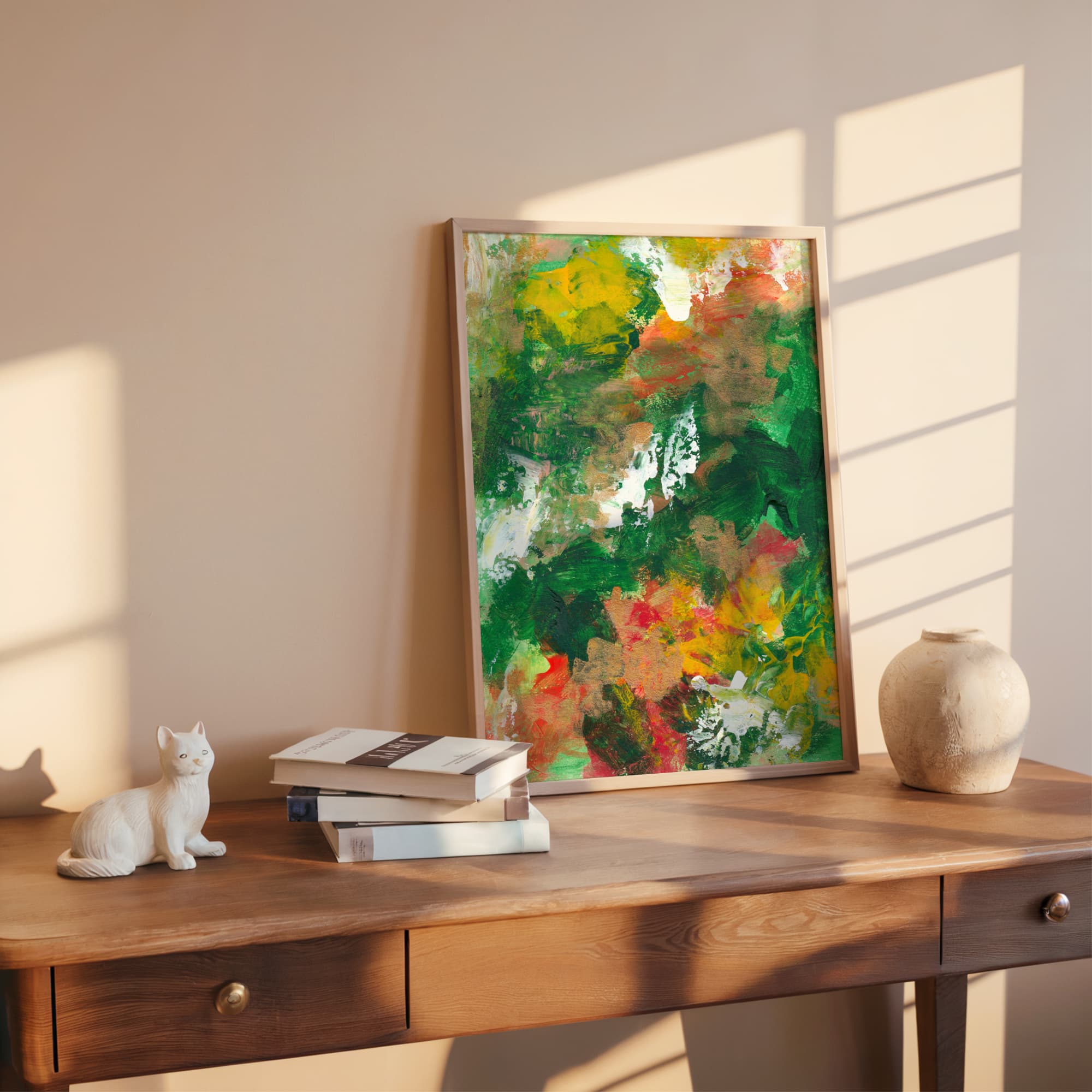The Ultimate Guide to Curating Personalised Wall Art for Mindful Spaces
A mindful space isn’t built by accident. You can light every candle, roll out every yoga mat, and still end up with a room that feels more like a waiting area than a sanctuary. The details matter, and on the walls, those details speak the loudest. That’s where personalised wall art comes in.
The word “personalised” has been hijacked in recent years by mugs with names slapped on them or algorithm-generated prints that try to look thoughtful. That isn’t what we’re talking about here. True personalisation in art isn’t about printing a date in a nice font. It’s about choosing work that resonates with you, work that carries weight beyond decoration, and curating it in a way that gives your space emotional presence.
This isn’t a quick “hang and forget” guide. It’s about depth. How you curate. Where you place. Why you choose. Whether your walls are part of your home, a studio, or a workspace that needs to hold stillness in the middle of chaos, the right art changes everything. It anchors the atmosphere and gives you a sense of belonging to the space you’ve created.
Why Personalised Wall Art Matters in Mindful Spaces
A mindful space is supposed to do one thing above all else: help you breathe differently when you’re in it. Everything you put into that environment is either pulling towards that goal or pushing against it. The wall art is particularly important because it isn’t passive. It greets you every time you walk in, it shapes the emotional tone of the room, and it sets the standard for what belongs and what doesn’t.
When the art is personalised, it stops being generic décor and becomes part of the emotional architecture of the space. You’re not just filling a blank wall. You’re creating a visual anchor that reflects what you need, stillness, focus, or even quiet energy.
This is why high-end collectors, interior designers, and anyone serious about mindful living are looking beyond “off-the-shelf” prints. They’re curating collections from private catalogues like the Collector’s Vault, where the work isn’t mass-produced or designed to match the sofa. It’s chosen for resonance, depth, and longevity. That’s the difference between having “art on the wall” and having a space that actually holds presence.
The Psychology of Resonance
Personalised wall art isn’t about ego. It isn’t even about taste in the superficial sense. It’s about resonance, the experience of seeing something that makes you feel understood without words. When that happens, the art doesn’t just decorate your space; it strengthens it.
Psychologists have long noted the link between environment and emotional regulation. If your walls are filled with noise (visual or otherwise), your nervous system never really settles. But when what you’re looking at resonates with you, your body interprets the space as safe, aligned, and worth resting in. That’s why choosing the right art is less about trends and more about attunement.
This is also why mindful collectors don’t respond to sales pitches. They aren’t interested in being persuaded that a piece is “important.” They’re interested in how it feels when it’s in the room with them. The role of a personalised catalogue is simply to give them the option of finding that feeling without the distraction of gallery theatre.
Choosing Depth Over Decoration
Most interiors today are built to impress on first glance. They’re styled for photographs, quick tours, or the fleeting scroll of social media. Everything matches, everything is coordinated, everything is designed to look “finished.” But here’s the problem: finished doesn’t always mean alive. A styled space can be beautiful to look at and completely flat to live in. You admire it once, and then it becomes background noise.
Decoration is built for that. It’s surface level. It’s about appearance rather than experience. It works well in hotel lobbies, show homes, and waiting rooms because no one is meant to spend enough time there to ask for more. A decorative piece is supposed to be nice enough to notice, bland enough not to offend, and neutral enough to ignore once you’ve seen it. That’s fine if you’re waiting for a dentist. It’s not fine if you’re building a space where you want to breathe differently.
Depth, on the other hand, is what makes a space feel lived. It doesn’t just dress the room; it roots it. When a piece of art has depth, it carries presence. It holds something for you, even when you’re not actively looking at it. It lingers in your peripheral vision and shifts the emotional atmosphere of the room without you needing to do anything.
This is why personalised wall art matters so much in mindful spaces. These aren’t rooms where decoration will ever be enough. Mindful spaces demand resonance. They need weight, subtlety, and a sense that the room is more than the sum of its styled parts. The art you put on the walls isn’t background; it’s the anchor.
And here’s where the shift happens. When you start curating with depth in mind, the questions you ask yourself change completely. Instead of:
Does this match the sofa?
Will this tie in with the curtains?
Is this the right shade of beige for the season?
You start asking:
Will I still want to sit with this when I’m tired?
Does this feel right in moments of reflection?
When I need to return to myself, will this piece help me land?
Those questions cut straight through decoration and into experience. They’re the ones that separate “styled” rooms from spaces that actually hold you. And once you’ve asked them, you can’t un-ask them. The art that once seemed “nice enough” suddenly looks empty. The walls demand something more considered. Something chosen not for appearance but for how it changes the way you feel when you’re in the room.
That is the difference between depth and decoration: one is for display, the other is for living. And in a mindful space, only one of those is worth your walls.
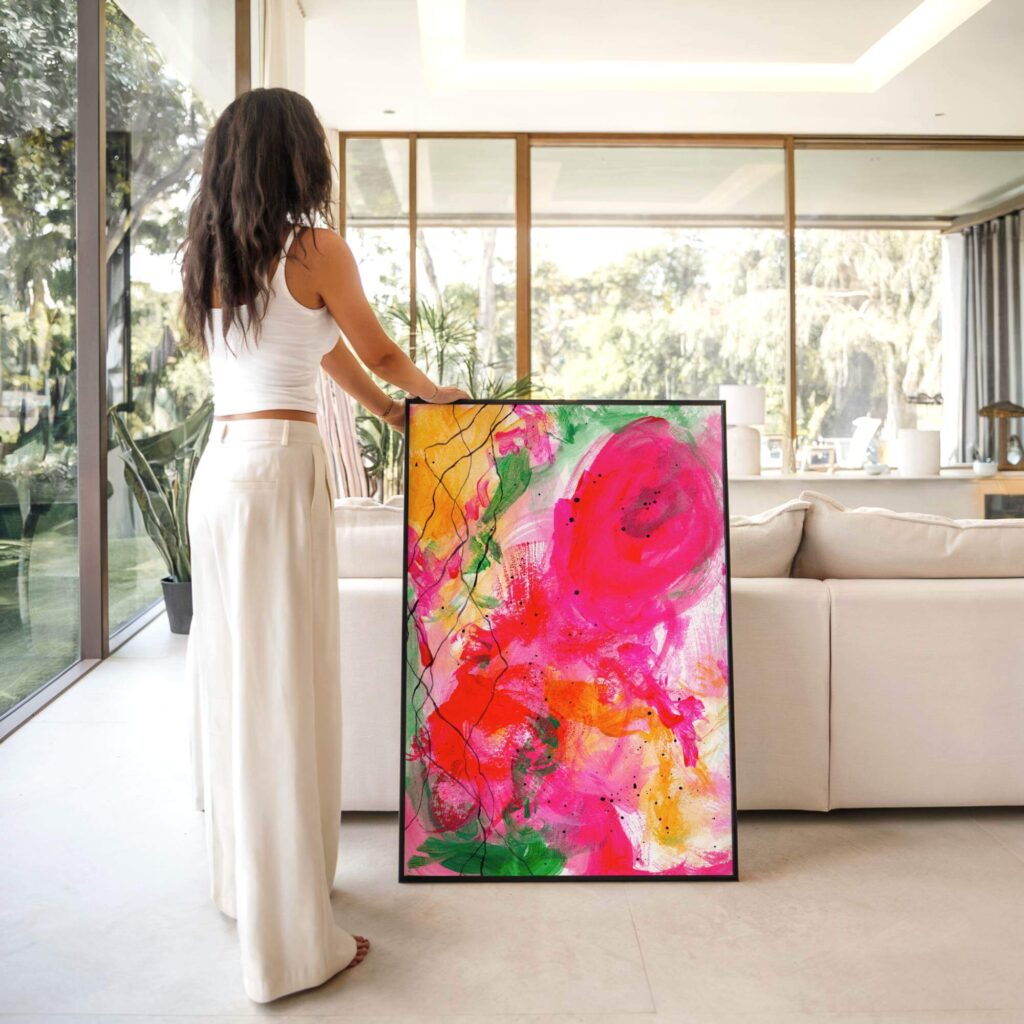
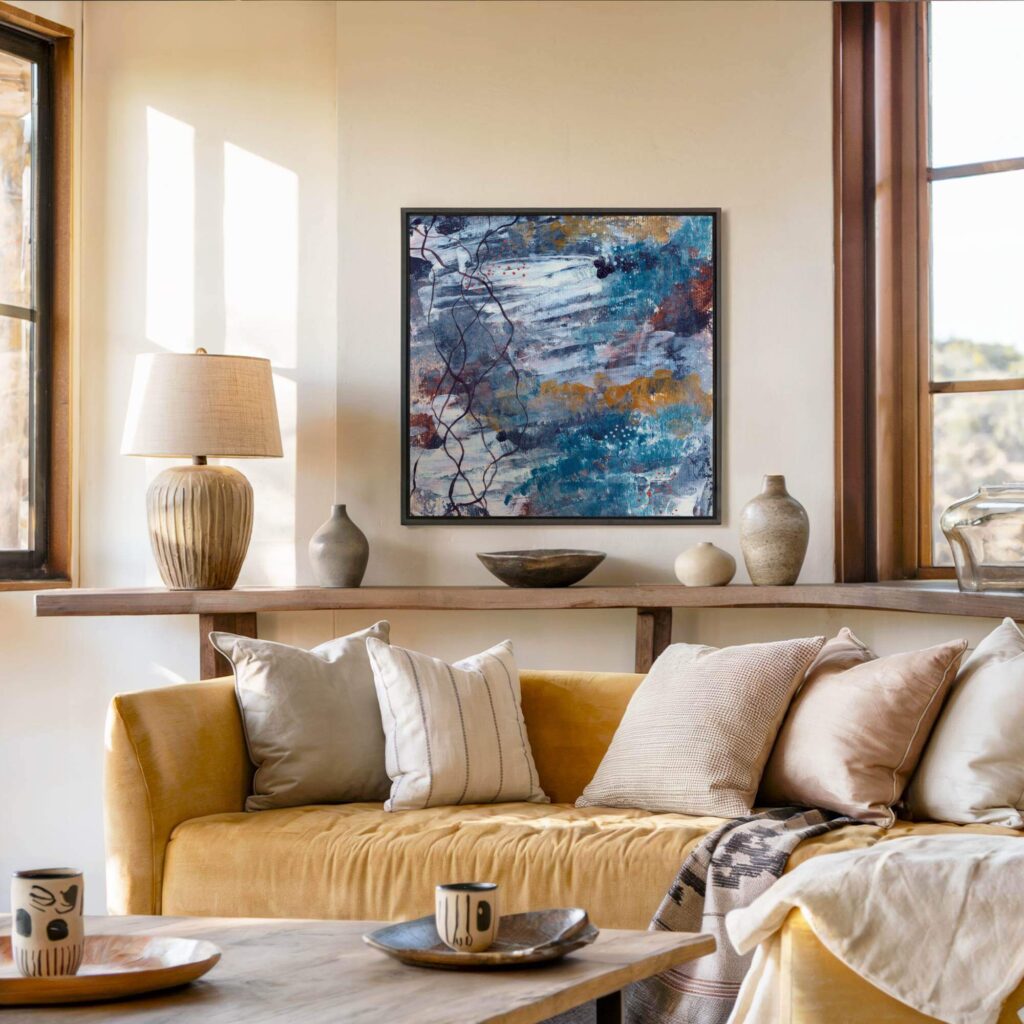
Why Decoration Fails in Mindful Interiors
At first glance, decorative art seems harmless. It brightens a wall, it fills a gap, it gives you something vaguely pleasant to look at while you sip your tea. But in a mindful space, where the entire purpose is to ground, restore, and attune you, decorative art does more harm than you’d think — not because it’s offensive, but because it’s empty.
The problem with decoration is that it was never designed to carry weight. It’s art reduced to an accessory. A splash of colour to tie in the cushions, a neutral print chosen because it was “safe,” or a generic canvas pulled from a catalogue because “something needed to be there.” That sort of art is built to be inoffensive, not to be lived with. It doesn’t sustain attention, and it doesn’t invite you into any kind of dialogue. The moment your eyes land on it, they slide away again. Nothing lingers.
In mindful interiors, that sliding away is a problem. These are spaces designed to encourage pause, stillness, and deeper presence. The room itself is part of the practice, whether that practice is meditation, yoga, journaling, or simply the quiet act of sitting with yourself after a long day. Every element in the space should help draw you into awareness. Decorative art interrupts that. Instead of deepening your sense of connection, it breaks it. You sit down to breathe, your eyes drift toward the wall, and what greets you is something shallow and generic. The nervous system recognises it instantly for what it is: filler. And filler never calms you, it just reminds you the space wasn’t curated with intention.
Think about the difference between background music and a song you actually love. Background music is fine for a supermarket because you’re not supposed to notice it. But would you put that same bland soundtrack on while you were trying to centre yourself? No. You’d choose something with texture, something that matches your state of mind. Decoration is background music for walls. It fills the silence but doesn’t enrich it.
Mindful spaces deserve more than filler. They demand art that can hold your gaze, art that resonates even when you’re not consciously analysing it. If the walls are decorated instead of considered, the whole atmosphere collapses into something flat and forgettable. And a flat atmosphere is the exact opposite of what a mindful space is trying to achieve.
This is why decoration fails: not because it’s ugly, but because it’s hollow. It doesn’t work against you in obvious ways, but it quietly robs the space of depth. You don’t notice its failure in one moment, you notice it in the way you never quite settle, the way the room never fully supports you, the way presence always feels slightly out of reach.
That is why mindful interiors can’t rely on decoration. They need something with more gravity.
Resonance as a Quiet Standard
Most of the language around interiors still revolves around trends, palettes, and “finishing touches.” It’s all about what looks right. But in mindful spaces, what looks right is never enough. What feels right is the real measure. And that measure is resonance.
Resonance is one of those words that gets borrowed a lot, but in this context, it has a very clear meaning. It’s what happens when you encounter something that continues to move inside you long after the first impression. You see it, and instead of sliding past, you stop. You keep looking. You find yourself coming back to it the next day, and the next, and the next. It doesn’t demand your attention with bright colours or oversized scale; it earns your attention through quiet staying power.
That’s what personalised wall art brings into a mindful space. It’s not about ticking a box on a design mood board. It’s about placing something on the wall that actively deepens your experience of being there. When you lie back on the mat, or sit in your favourite chair, your eye finds the work, and instead of breaking the moment, it carries you deeper into it. That’s resonance.
It’s also worth saying that resonance doesn’t mean “perfection.” In fact, often the works that resonate most aren’t polished, symmetrical, or designed to match the lampshade. They’re the ones with texture, with subtle tension, with an energy that refuses to be flattened. They feel human. And because they feel human, they keep meeting you at different points of your own experience. Some days the same piece will feel calming. Other days it might feel charged, or even slightly unsettling. That’s not a flaw, it’s exactly what makes it alive.
The quiet standard of resonance is a different kind of benchmark than what most people are used to. Instead of asking, “Will this impress a visitor?” you ask, “Will this continue to meet me where I am?” It’s not about creating a photo-ready space but a space that expands with your own inner states. That means resonance isn’t a one-time test. It’s ongoing. You’ll know a piece has it because it doesn’t fade into the background. Instead, it integrates, it evolves, and it keeps giving.
And that’s why resonance is such a powerful standard for mindful spaces. It’s not loud, it’s not showy, and it doesn’t need an explanation on a placard. It just works, over and over again, in silence. The more time you spend with it, the more you realise it’s not just art on the wall. It’s a quiet companion to the life unfolding in the room.
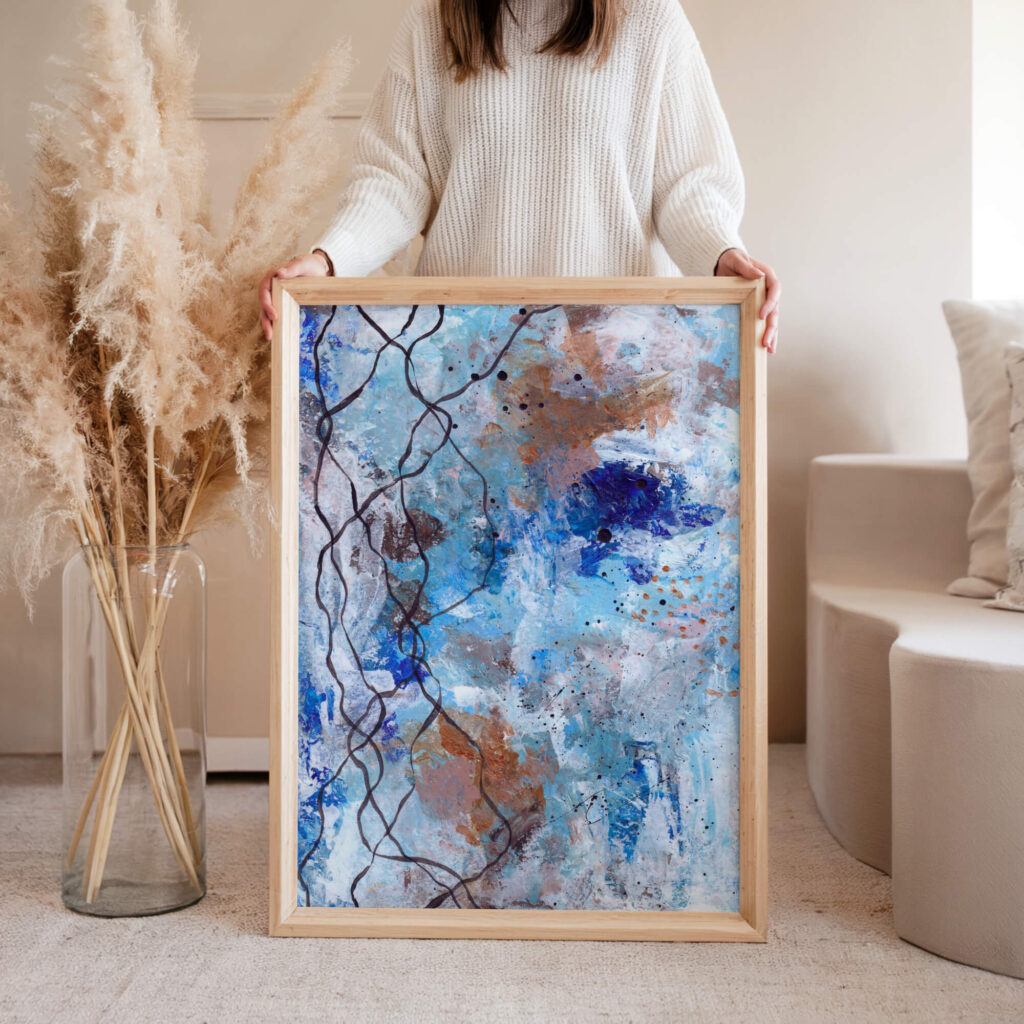
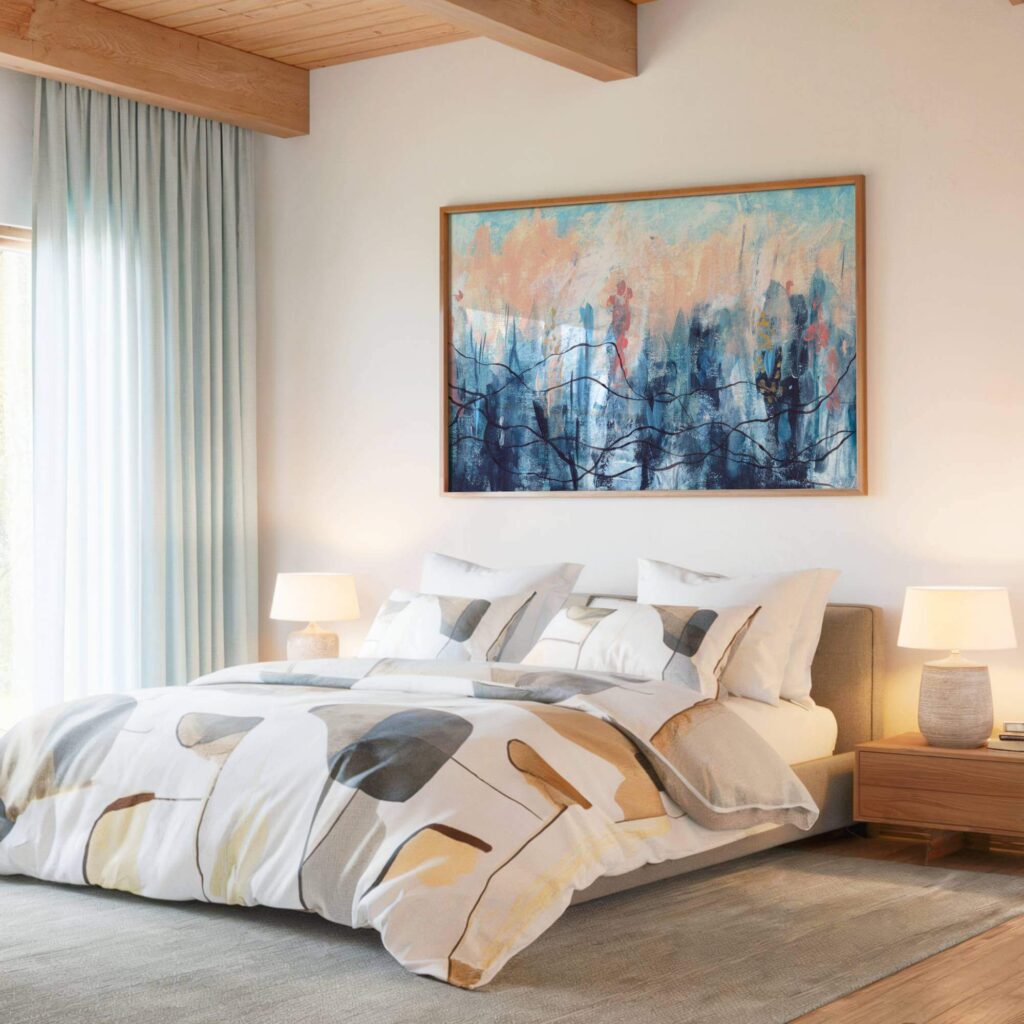
The Role of Personalisation in Stillness
Stillness is often misunderstood as a kind of blankness. People imagine empty white walls, bare floors, silence so sharp it feels sterile. But real stillness has texture. It’s not the absence of everything; it’s the presence of the right things. And that’s where personalisation comes in.
When you walk into a space that has been personalised, you immediately sense the difference. It carries the imprint of care. Something about it says, “This was chosen for here, for now, for me.” That intentionality shifts how you feel in the room. Suddenly, you’re not in a styled set or a borrowed environment; you’re in a place that holds part of you. And that makes stillness easier to enter.
Personalisation doesn’t mean plastering your walls with family photos or motivational slogans (unless those genuinely ground you). It means curating art that reflects your inner state, your rhythms, your way of coming back to yourself. In mindful spaces, this becomes more than an aesthetic choice. It becomes a form of alignment. You’re telling your nervous system: this room is safe, this room is mine, this room is here to support me.
The mistake many people make is assuming that stillness can be mass-produced. That you can buy a print from a catalogue, put it on the wall, and suddenly achieve peace. But stillness doesn’t work that way. It isn’t something you import; it’s something you cultivate. Personalisation is the act of cultivation. It ensures that the art on your walls isn’t generic filler, but a direct extension of your own presence.
The beauty of personalised art in this context is that it doesn’t need to shout to prove its relevance. It doesn’t need to follow a trend or satisfy anyone else’s taste. Its value lies in how it feels when you share a room with it. Does it let you breathe differently? Does it help you settle when the world outside is unrelenting? Does it make you want to sit for a few minutes longer, instead of rushing back into distraction? If the answer is yes, that’s the role of personalisation working exactly as it should.
And here’s the deeper truth: stillness is not passive. It’s not an absence of movement or noise; it’s an active state of being present. Personalised wall art helps anchor that presence. It doesn’t just decorate the room; it participates in the process of slowing you down, of drawing you inward, of creating an environment that feels like it’s on your side.
In other words, personalisation isn’t a nice extra. It’s part of the very architecture of stillness. Without it, the room might look calm, but it won’t feel calm. With it, stillness becomes less of an aspiration and more of a lived reality.
From Generic Prints to Intentional Presence
Most people start their relationship with wall art the same way they start their relationship with furniture: by filling a gap. There’s a blank wall, it looks empty, and the solution seems obvious, buy something to cover it. That’s why so many homes are filled with generic prints. They’re easy to find, easy to frame, and easy to forget.
The trouble is, generic prints behave exactly as they’re designed to: they fill space without ever really entering it. You glance at them once, register something vaguely pleasant, and then never look again. They’re the visual equivalent of polite small talk. Harmless, but forgettable.
In mindful spaces, forgettable doesn’t cut it. These are not rooms that benefit from polite filler. They are environments intended to draw you into deeper presence, which means every object within them has to be intentional. That’s where the shift from generic prints to intentional presence comes in.
Intentional presence means that a work of art has been chosen not just to look acceptable, but to participate in the atmosphere of the room. It acknowledges that art isn’t background decoration, it’s part of the lived experience. The same way you wouldn’t soundtrack a meditation with a ringtone, you shouldn’t soundtrack your mindful space with art that carries no depth.
The difference becomes obvious once you live with both. A generic print is something you forget until you have to dust it. An intentional piece is something you find yourself in dialogue with, whether you mean to or not. You sit down to breathe and your eyes are drawn to it, not because it demands attention, but because it offers it. It meets you halfway.
This doesn’t mean you need to overthink every choice or turn art into homework. Intentional presence is about clarity, not complication. It’s asking yourself the simple questions: “Why this piece? Why this space? Does it actually contribute to the kind of environment I want to inhabit?” If the answers feel thin, the art will feel thin too. But if the answers carry weight, the work will hold that weight for you, day after day.
The move from generic prints to intentional presence is subtle, but once you make it, you can’t unsee the difference. A room that once looked “fine” suddenly feels flat, because you know what it could be doing instead. That’s when you stop treating art as a placeholder and start treating it as part of the architecture of your presence.
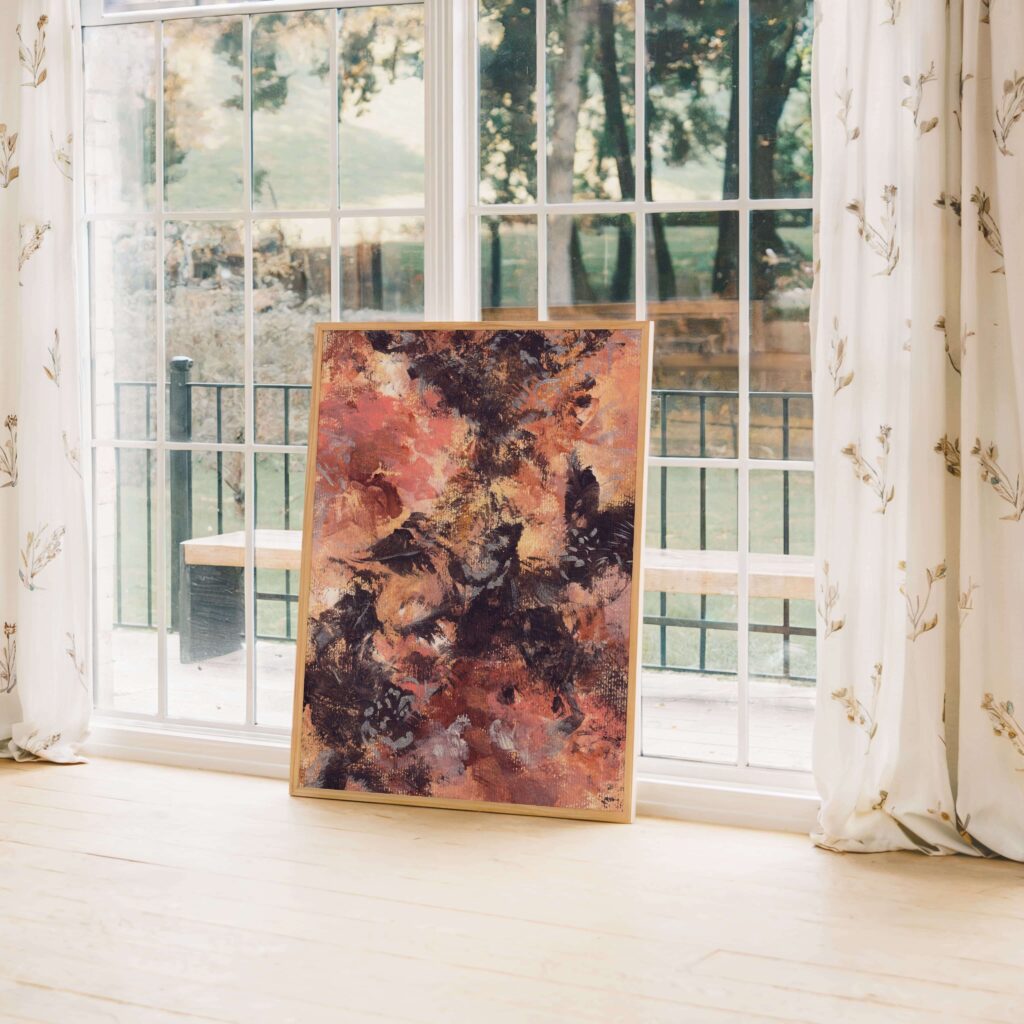
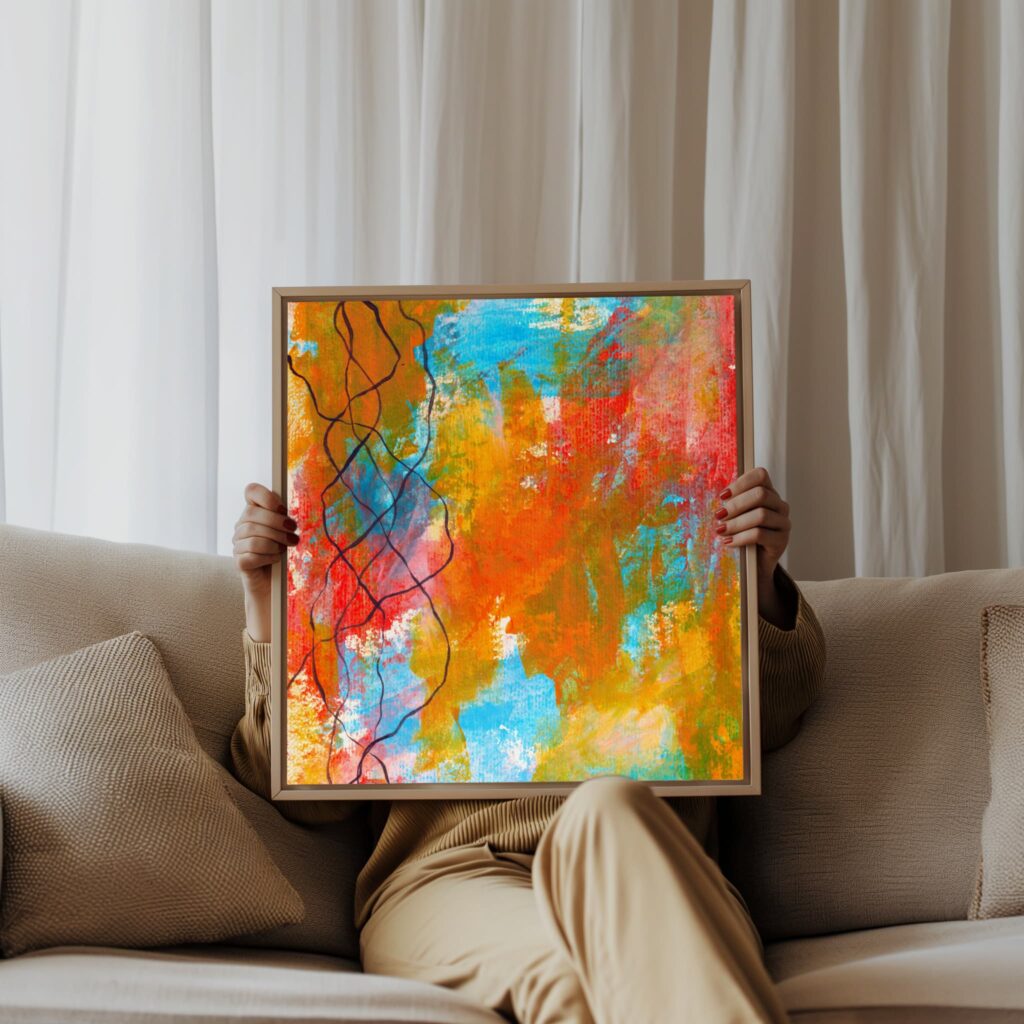
How Art Shapes the Emotional Atmosphere of a Room
Walk into any room and your body reacts before your brain does. Shoulders drop or tighten. Breathing slows or gets shallow. You either want to linger or you want to leave. That reaction isn’t random. It’s the atmosphere of the room, and whether you know it or not, art is one of the fastest ways it takes shape.
We tend to talk about interiors as if they’re just a sum of their parts, furniture, colours, and lighting, but art slips under the radar and does something more subtle. It doesn’t just decorate a wall. It tunes the space. A generic print is like wallpaper music: you hear it, you ignore it, you move on. The room feels flat, polite, and safe. But a piece of art with depth changes the pressure in the air. It shifts you into a different state, whether you intended it or not.
That’s the thing most people don’t realise: walls aren’t neutral. Whatever you put on them carries energy that you have to live with. And if you live with it long enough, it shapes your nervous system. A painting that unsettles you doesn’t only unsettle you while you’re looking at it. It lingers. The same goes for art that calms you, or grounds you, or gives you a quiet sense of perspective. Over time, those signals build up, and you start to feel them as part of the room itself.
This is why decoration alone fails. A perfectly styled space might look impressive in photos, but you don’t live in a photograph. You live in an atmosphere. And the atmosphere has a longer memory than you think. Once you’ve experienced a room that feels anchored by art chosen with intention, it’s difficult to unlearn that awareness. Suddenly, you notice when a space feels hollow. You notice when it’s all surface and no presence.
Mindful spaces work differently. They aren’t asking you to match a sofa or fill a blank wall for the sake of it. They’re asking you to choose art that can act almost like a co-host, setting tone, easing tension, and making the room somewhere you actually want to be. The right work doesn’t just hang there. It collaborates with you. It creates an emotional weight you can lean on.
That’s the difference between a room that looks styled and a room that feels lived. One photographs well. The other holds you when you need it most.
Personalised Wall Art as a Daily Practice
Personalisation gets thrown around a lot, usually meaning someone sticks your initials on a mug and calls it meaningful. With wall art, it’s not about gimmicks. It’s about building a space that actually reflects the life you’re living. A personalised piece isn’t necessarily one that literally has your name stitched into it. It’s one that carries enough of your story, your values, or your emotional state that you feel it resonate every time you pass it.
The mistake many people make is thinking of art as something static — something you acquire once and then ignore. In mindful interiors, it works more like a practice. You interact with it. Some days you notice it fully, others you barely glance at it, but either way it shapes the rhythm of your environment. It can mirror where you are, or remind you where you want to return. That’s the quiet power of a personalised choice.
It doesn’t mean the piece has to be commissioned to your exact specifications. It might simply be that a particular work feels like it was speaking to you directly, even if the artist didn’t know you existed. That feeling of recognition is a form of personalisation in itself. You’re not buying a trend, you’re acknowledging resonance.
Over time, this becomes less about possession and more about a relationship. The artwork isn’t there to impress guests or tick a box in a design plan. It’s there to keep you company. To sit with you when you’re tired. To hold a version of you that you can’t always express in words. In that sense, choosing personalised art is closer to a ritual than a purchase.
And here’s the practical side: when you choose art this way, you make it harder to clutter your space with things you don’t really need. You stop buying fillers because you know they won’t stick. Instead, you choose slowly, with depth, and the walls become a reflection of what actually matters to you. That’s the kind of daily practice most people never realise art can be.
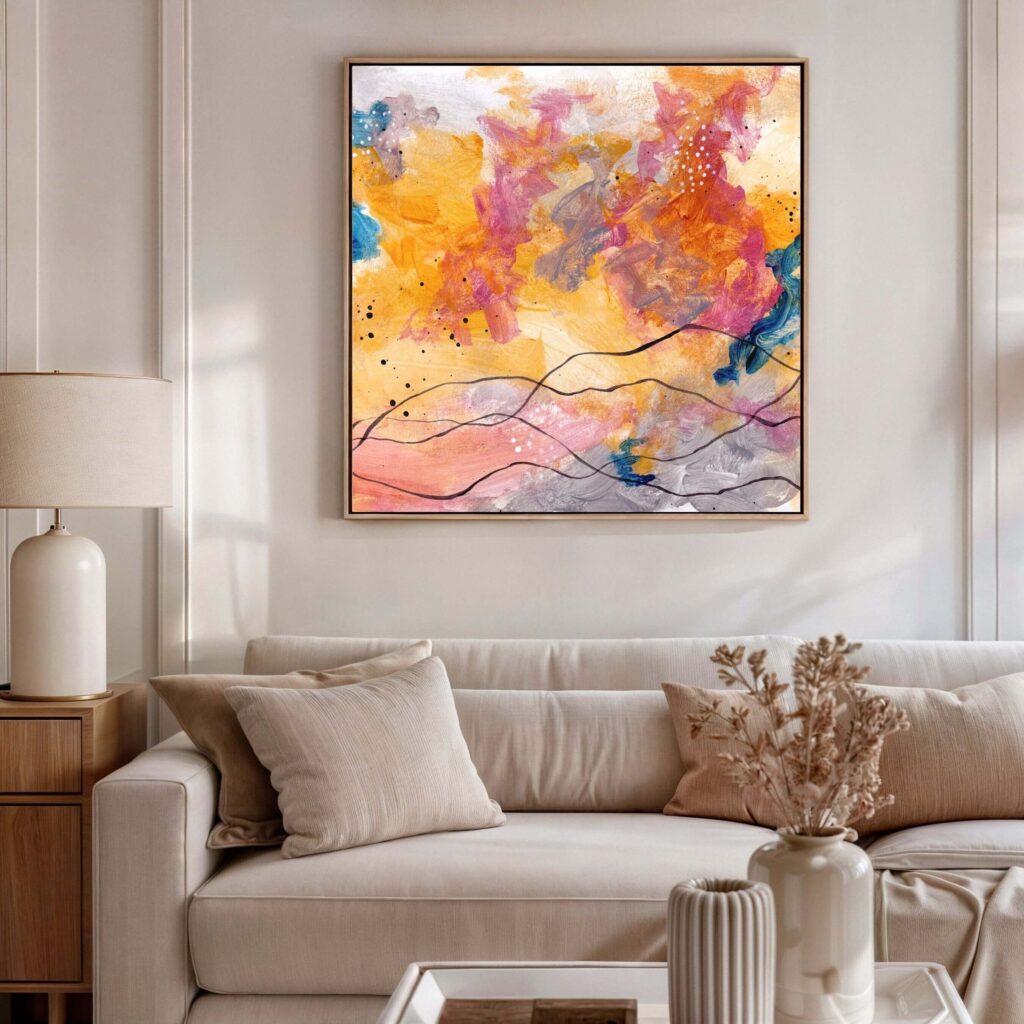
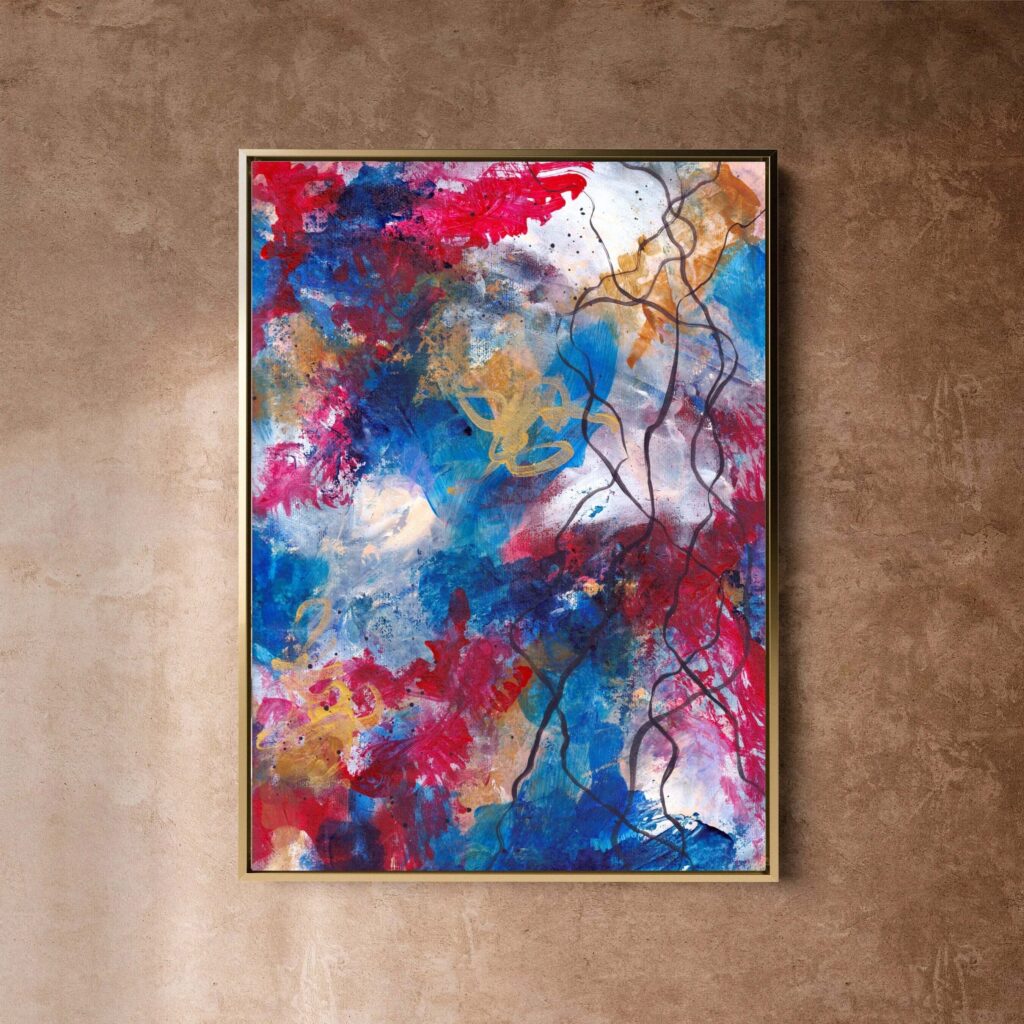
Why Generic Décor Doesn’t Last
There’s a reason the print you picked up at a department store ends up in the attic within a year. Generic décor looks harmless, but it rarely holds up. At first, it seems like a quick fix: a splash of colour, a neat shape, something to “finish the room.” But the novelty wears off quickly. Once you’ve lived with it, you realise it doesn’t give anything back.
The problem isn’t that it’s cheap. Expensive can be just as hollow if it’s chosen without care. The real issue is that generic art is designed to appeal to everyone, which means it rarely speaks to anyone in particular. It’s decoration that fills a gap, not presence that fills a room. You hang it, you forget it, and before long you don’t even see it anymore.
And when you stop seeing something, you also stop feeling it. This is what makes generic décor disposable. It has no staying power because it never built a relationship with you in the first place. It’s like background noise: fine for a while, but eventually irritating when you notice it doesn’t mean anything.
Mindful spaces demand more. They ask for art that changes the atmosphere, that has weight and personality. When you choose generically, you rob the room of that possibility. You leave yourself surrounded by surfaces that don’t move you. Over time, that lack of connection becomes obvious. You might not articulate it in those words, but you’ll find yourself restless, replacing things, chasing a sense of “completion” that never arrives.
The alternative is slower, but far more sustainable. Choosing art with depth means you choose pieces you can live with. Works that might challenge you at times, or comfort you, or remind you of something you don’t want to forget. These are not quick hits. They’re long-term presences. That’s why they last. They grow with you.
And here’s the irony: when you stop chasing generic fillers, you often need less. One piece of meaningful art can hold a wall better than five forgettable prints. The room feels complete, not because it’s full, but because it’s resonant. That’s the difference between a décor choice and a collector’s choice.
The Psychology of Resonance in Interior Design
Resonance sounds like one of those overused words designers throw around, but it actually has a very practical weight to it. When we say something resonates, what we really mean is that it lands in a way we can feel. It vibrates with something inside us. And once you’ve experienced that in a room, it changes how you think about interiors altogether.
Interior design is often framed as a visual exercise, but our nervous systems don’t separate sight from feeling. What you see on the walls feeds directly into how your body behaves in a space. Think of it like sound: a single note can be pleasant, but when it strikes the right chord with the acoustics of the room, the effect is amplified. That’s what resonance is in design. The art on the wall isn’t just a picture; it’s a tuning fork for the whole atmosphere.
This explains why some spaces make you feel instantly at ease while others leave you unsettled without you knowing why. A mismatched or hollow piece of art can jar against the energy of the room, like a wrong note in a song. You might not consciously notice it, but your body does. On the other hand, when the art harmonises with the space and with you, the effect is grounding. You relax. You want to linger.
Psychologists often talk about the way humans attach meaning to objects. We’re wired to seek significance, to connect our environment with our internal state. Resonant art takes advantage of this wiring in the best possible way. It doesn’t just hang on the wall; it anchors your experience of the space. Over time, that anchoring becomes part of how you live in the room.
This is why resonance isn’t a luxury add-on, it’s the foundation of mindful design. Without it, a space might look polished but will always feel slightly off. With it, even the simplest room can hold a surprising depth.
And here’s the key point: resonance can’t be faked. You can’t buy it by following trends or matching colour schemes. It has to come from art that genuinely connects with you, the inhabitant. That’s why the psychology of resonance matters more than any styling trick. It reminds us that rooms aren’t just containers. They’re emotional environments, and the art you choose decides how they speak.
My Offerings for Discerning Buyers & Designers
I’ve worked with interior designers, luxury hotels, executive teams, and private collectors who value emotional depth, spatial harmony, and long-term resonance. I offer:
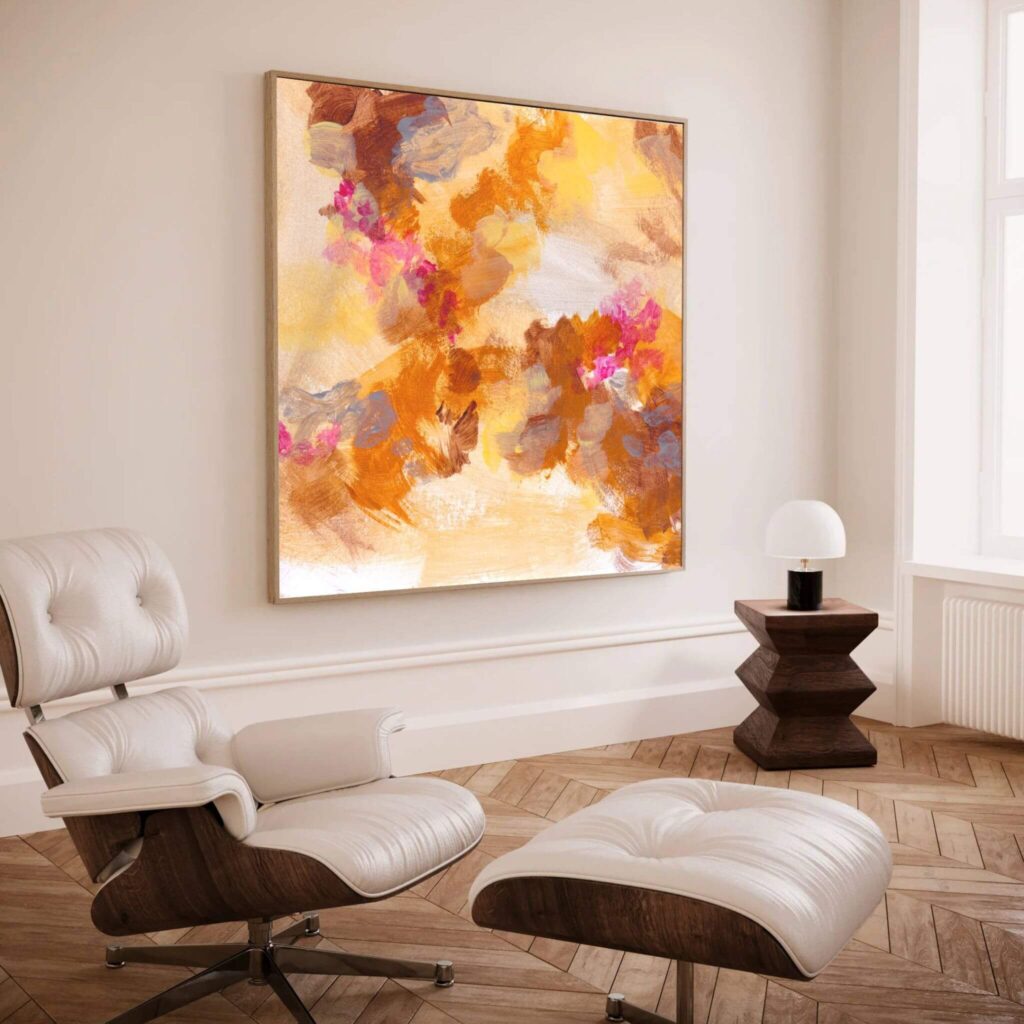
Collector's Vault
Canvas prints from the archive, made with emotional resonance and sustainable materials for spaces seeking depth.
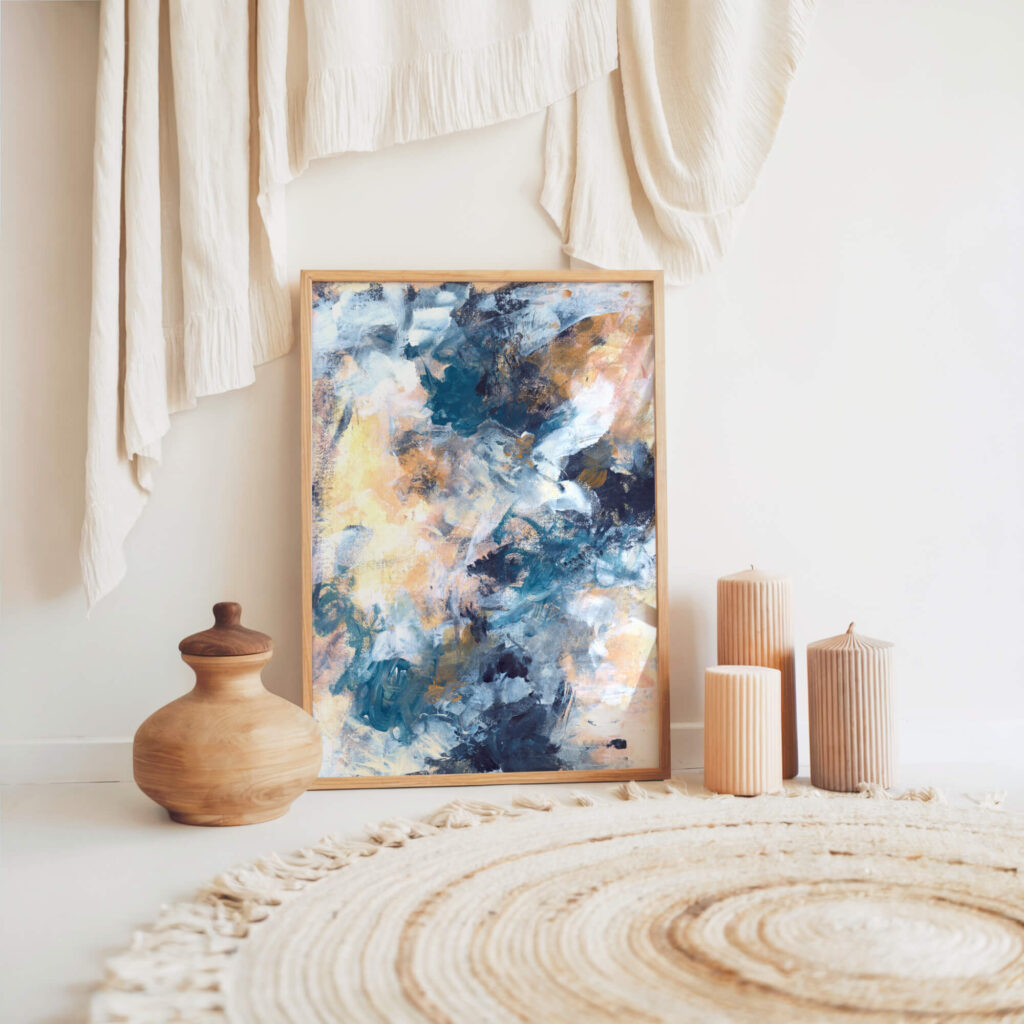
Capsule Commission
Created privately, one at a time, through stillness and reflection. Limited spaces each season to preserve depth and intimacy.
The Last 10
Ultra-limited, hand-embellished editions. No more than ten will ever exist. Made to ground, steady, and hold presence at the highest tier.
Why Personalised Art Creates Emotional Anchors
When you think about the spaces that stay with you, it’s rarely because of the paint colour or the size of the sofa. It’s usually because something in the room held a feeling you couldn’t shake. That’s what personalised art does, it becomes an anchor. Not in a heavy, stuck way, but in the sense of grounding you to something meaningful.
Most interiors float. They’re built to look good for a season, and then they drift. Anchors stop the drift. When you choose a work of art that carries part of your story or reflects a depth you need, it creates a fixed point in your space. You know where you are because of it. It offers you something to return to, whether you’ve had a good day or a fractured one.
The emotional anchor doesn’t come from personalisation in the surface-level sense. It’s not about “customisation” or novelty. It comes from recognition. When a piece of art feels like it has recognised you, when you stand in front of it and something inside you says, “Yes, that’s me”, that recognition turns into attachment. You don’t discard it when the trend moves on because it isn’t about trends. It’s about belonging.
That’s why personalised art tends to last longer than anything chosen to fill a gap. It’s not disposable because you’ve built a relationship with it. Like an old friend, it doesn’t need to entertain you every time you see it. It simply has to be there. That presence is enough.
There’s also a subtle psychological effect at play. Anchors reduce decision fatigue. When you have art in a room that you know belongs, you don’t keep questioning the space. You’re not scanning the walls thinking, “Something’s missing.” The anchor does the work of settling the atmosphere, which frees you to use the space for its actual purpose: living, working, resting, whatever it may be.
In mindful interiors, this is invaluable. Life throws enough uncertainty around without your environment adding to it. Personalised art acts as a stabiliser. It holds space for you so that you can focus on the rest. And that’s the real reason collectors invest in it: not just for beauty, but for grounding.
The Role of Abstract Art in Mindful Interiors
Abstract art has always carried a strange power in interiors. It doesn’t tell you what to see. It leaves the door open. That freedom is exactly why it works so well in mindful spaces. Instead of prescribing an image, it creates an environment for reflection.
When you walk into a room with figurative art, you know instantly what you’re looking at. There’s a story handed to you, a narrative you’re supposed to follow. It can be beautiful, but it’s directed. Abstract art is different. It removes the script and invites you to step into your own. That absence of instruction is what gives the work its meditative quality.
Mindful interiors benefit from this openness. A yoga studio, a meditation corner, or even a quiet corner in a busy home doesn’t need more instruction. It needs permission. Abstract art gives that permission by refusing to lock you into a single meaning. Instead, it mirrors your inner state. On one day, the same piece might feel grounding. On another, it might feel expansive. You’re not pinned down by it; you’re reflected in it.
Psychologically, this is what makes abstract art so durable in personal environments. Because it doesn’t rely on one fixed interpretation, you don’t outgrow it. It evolves with you. It becomes part of your daily rhythm, meeting you wherever you are. That’s rare in décor, where most things lose their impact over time.
There’s also a practical element worth noting. Abstract art integrates easily into interiors without competing with other design choices. It can hold a wall with authority, but it doesn’t overwhelm the rest of the room. Instead, it shapes the mood in subtle ways, softening, energising, grounding, depending on the palette and form. This flexibility makes it invaluable for designers working on mindful spaces where atmosphere matters more than spectacle.
Collectors often choose abstract works for the same reason. They want something that won’t exhaust them after six months of living with it. Something that doesn’t demand attention but rewards it when given. That balance, of presence without pressure, is exactly why abstract art continues to define mindful interiors across both private homes and professional wellness spaces.
At its core, abstract art doesn’t just decorate. It resonates. And in mindful interiors, that resonance is what transforms a room from styled to sustaining.
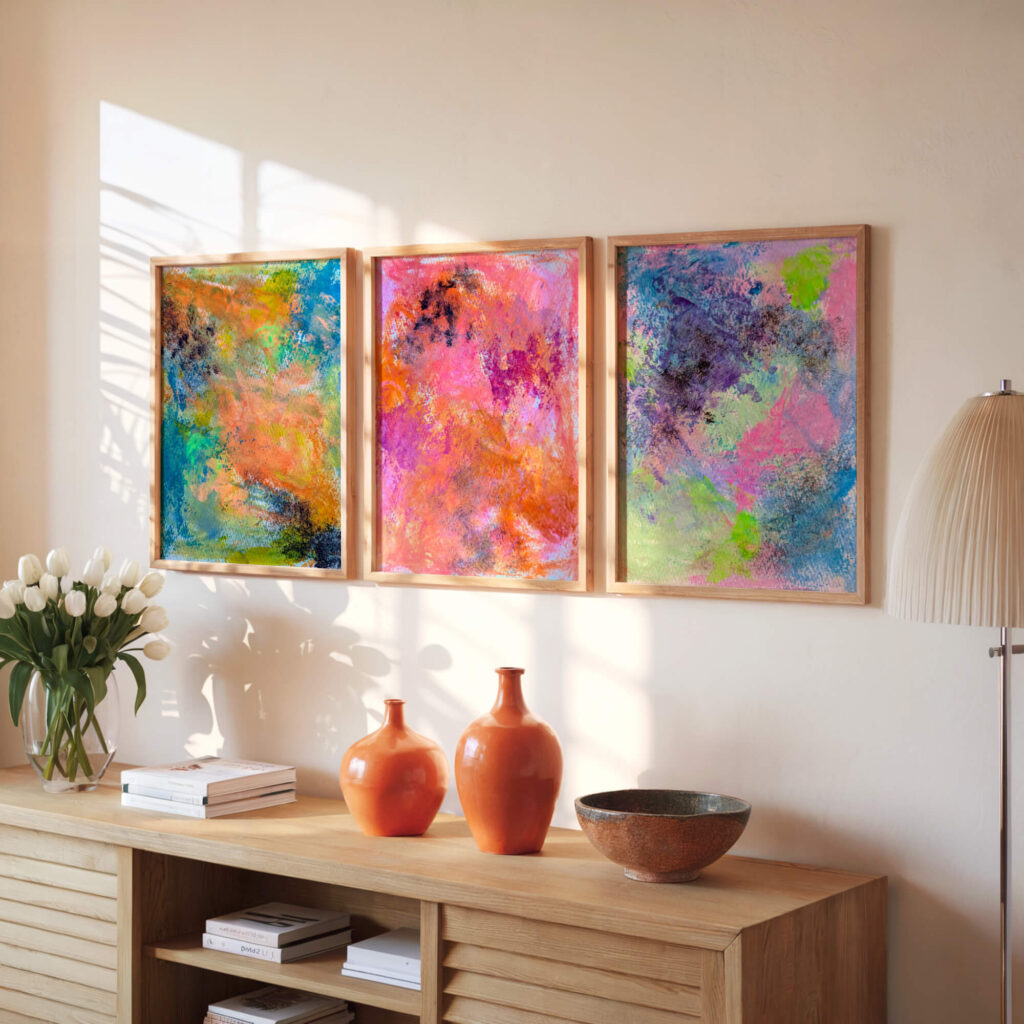
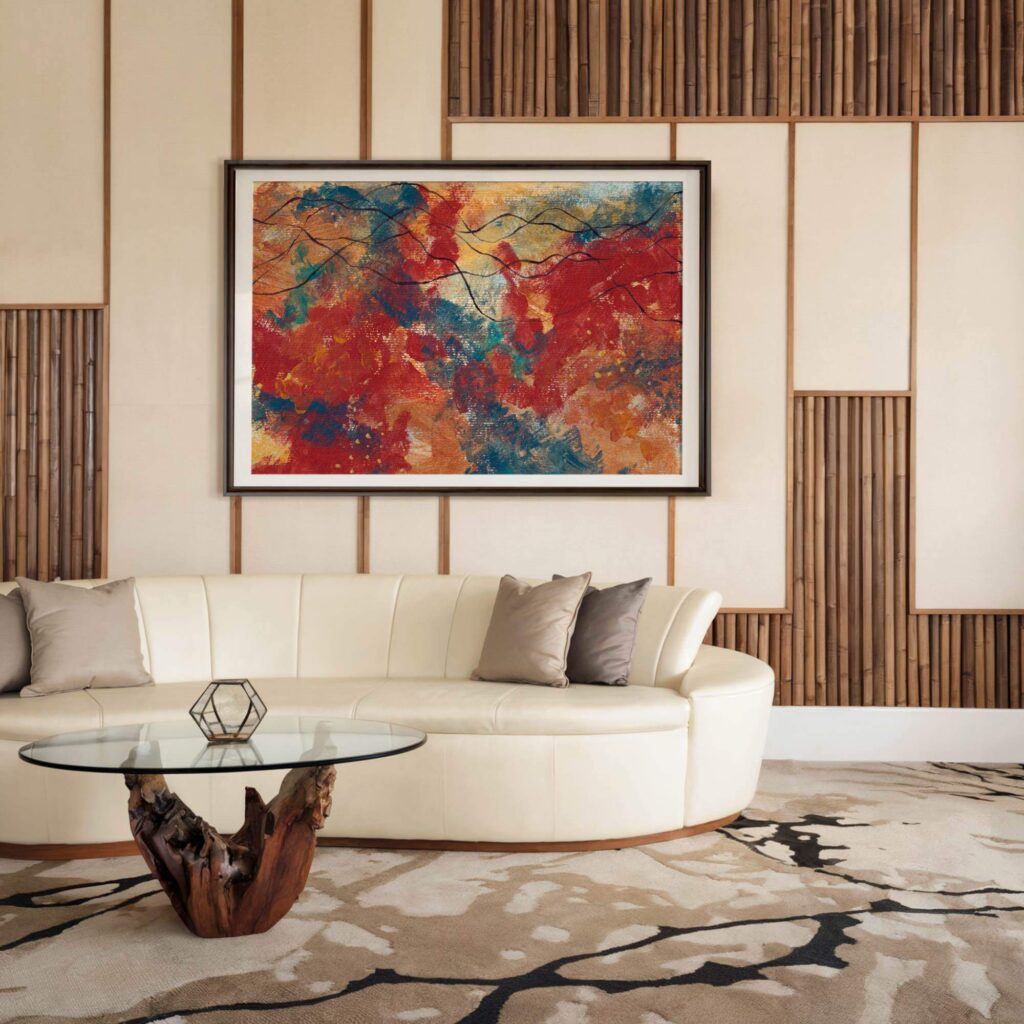
When Art Becomes a Daily Practice
Most people think of art as something you look at occasionally. You notice it when you first buy it, or when a guest comments on it, and then it blends into the background. In mindful interiors, the opposite happens. The art doesn’t disappear, it becomes part of your daily rhythm.
When you live with a piece long enough, it starts to function like a practice. Not in the same way as sitting on a meditation cushion, but in a quieter, more ambient sense. You pass it every morning on the way to the kitchen, or you catch it in your peripheral vision while winding down at night. Those small, repeated moments of engagement build into a relationship. You’re not just living in the room; you’re living with the work.
That repetition is powerful. The human mind is wired to respond to ritual. We rely on touchstones to create stability. Art can become one of those touchstones when it’s chosen with intention. Instead of being a static object, it becomes a companion in your day, something that reflects where you are, reminds you to pause, or simply steadies the atmosphere.
For some, this daily practice is conscious. They stop in front of a painting, breathe with it for a moment, and use it as a cue to reset. For others, it’s unconscious. The presence of the work subtly shifts how they feel in the space without them having to do anything about it. Either way, the effect is the same: art is no longer a backdrop. It’s an active part of the environment.
This is one of the reasons people talk about “living with art” instead of “owning art.” Ownership implies possession. Living with it suggests a relationship. And in mindful spaces, the relationship is what matters. The art isn’t there to impress your guests; it’s there to interact with you, day after day.
Once you’ve experienced that, the idea of decoration feels flimsy. Why settle for something that fills a wall when you could have something that shapes your inner state every time you see it? That’s the shift, art stops being an accessory and becomes part of your practice of presence.
Why Collectors Are Moving Towards Personalised Works
Collectors used to chase rarity, signatures, and the thrill of acquisition. That still matters to some, but the landscape is shifting. Increasingly, high-level collectors are turning towards works that feel personal rather than simply prestigious. They’re not just buying a name; they’re buying resonance.
Part of this comes from fatigue. The art market is crowded, noisy, and endlessly competitive. Public shows and galleries often frame collecting as a performance, who bought what, how much it went for, and where it will be hung. But collectors are real people with real lives, and many of them don’t want their walls to look like an auction catalogue. They want their walls to mean something to them.
That’s where personalised works enter the picture. Whether it’s a commissioned piece shaped by private reflection, or a canvas chosen from a vault of unseen works, the emphasis is on emotional fit. It’s about the private weight a piece carries, not the public spectacle it can create.
The rise of personalised collecting is also about sustainability. If you’ve lived through cycles of buying for prestige, you eventually realise how much ends up in storage. Pieces that looked good on paper rarely survive the test of time in a living environment. Personalised art, by contrast, tends to stay on the wall. It belongs there because it belongs to you.
This isn’t just a trend. It’s an adjustment to how collectors see value. In the past, value was determined by scarcity and reputation. Now, emotional alignment is entering the equation. A piece that feels like an extension of your own interior life is worth more than a piece that makes a dinner guest nod politely.
For mindful collectors, this matters most of all. They’re not chasing validation. They’re chasing presence. A personalised work offers them that presence without compromise. It doesn’t ask them to explain it to anyone else. It simply holds space in a way that feels necessary.
That’s why private catalogues and commissions are becoming so relevant. They move the focus away from spectacle and back to intimacy. And for collectors who already have more than enough to look at, intimacy is the rarest thing of all.
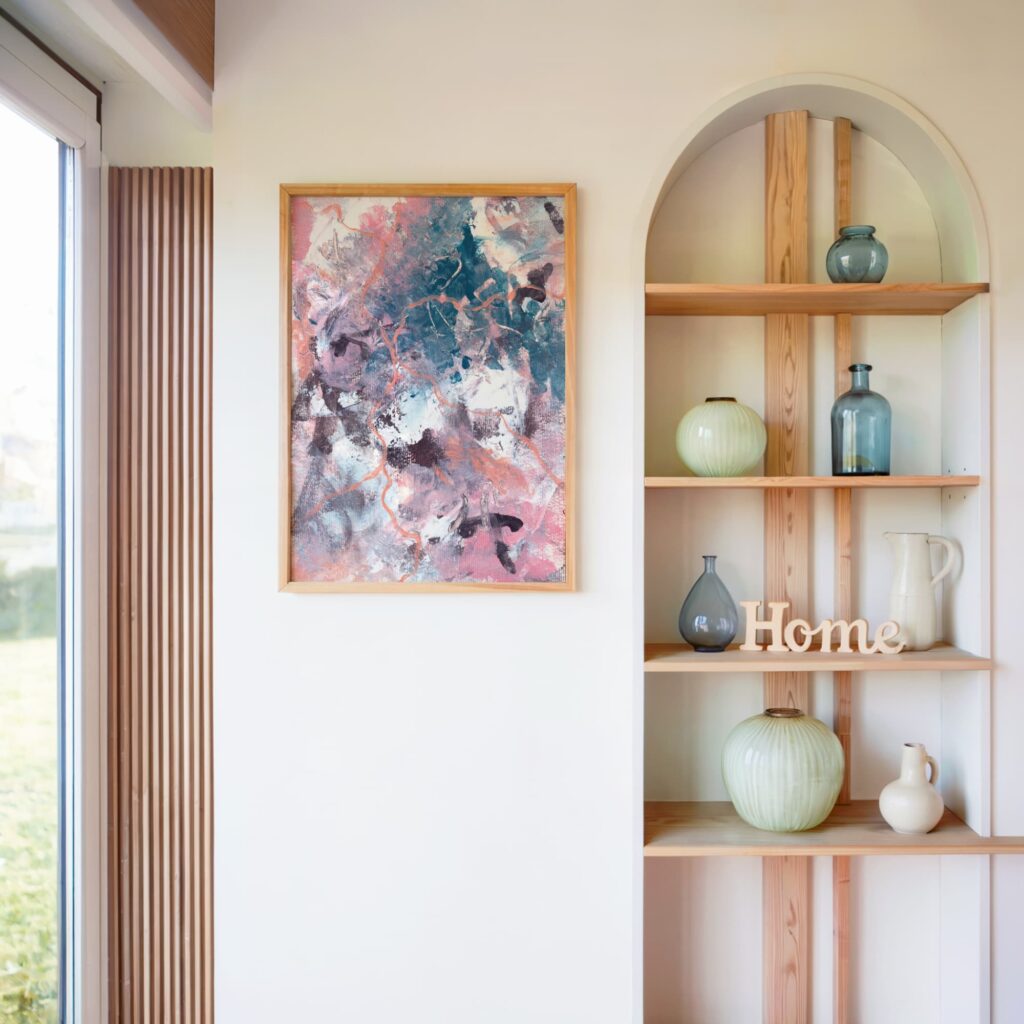
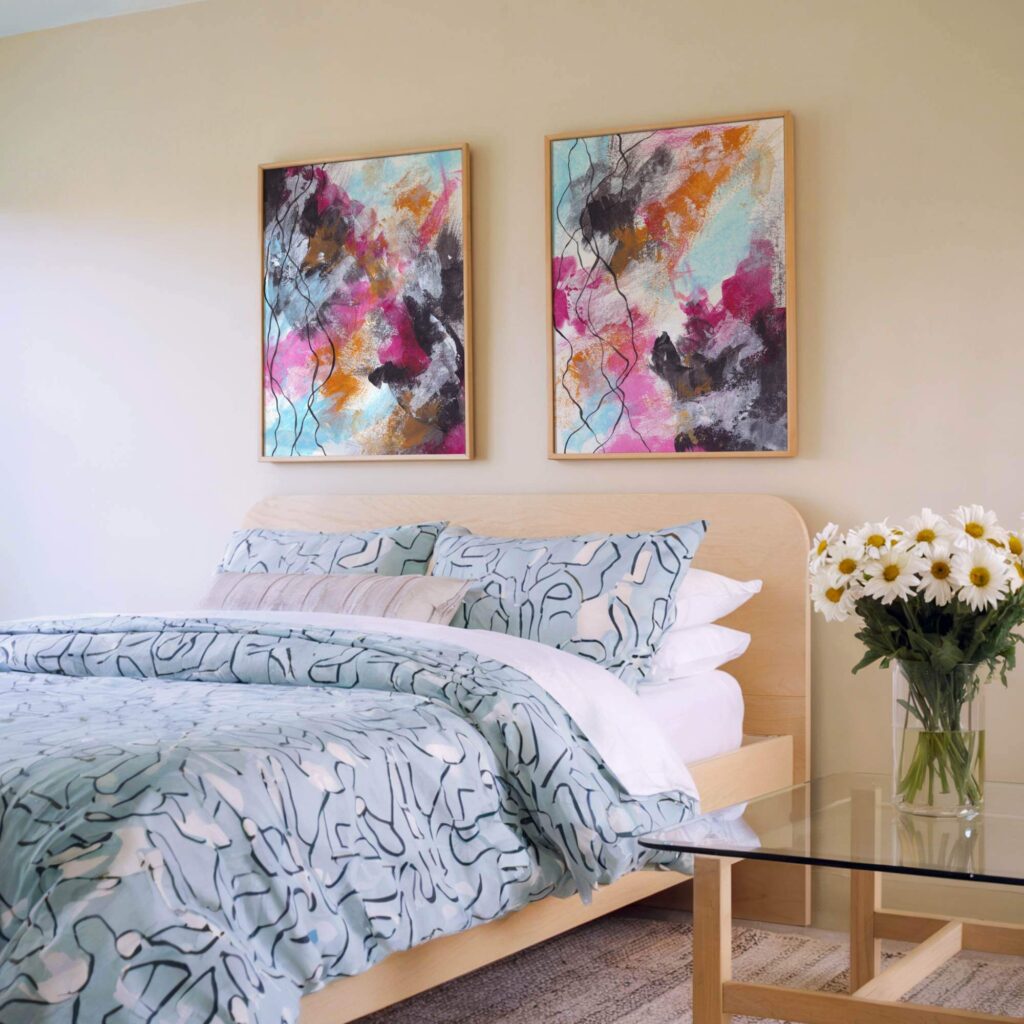
Private Catalogues as the New Galleries
Most galleries aren’t really designed for choosing art. They’re designed for being seen choosing art. There’s the staged lighting, the polite glass of wine, and the quiet pressure to look like you’re making the “right” decision. It’s theatre. And like any theatre, you clap at the end, go home, and wonder what actually stuck.
Private catalogues work differently. There’s no audience, no script, no need to perform. You see work in its raw state, without the marketing gloss. You take your time. You sit with it on your own terms. That’s when you start noticing which pieces hold, and which ones fall away the moment the performance ends.
For collectors, this shift matters. It means buying art isn’t about signalling, it’s about living. Instead of wondering how something looked in the room full of people, you think about how it feels in the room you return to every day. That difference is subtle, but it changes the entire experience of collecting.
And that’s why private catalogues are replacing public walls. They aren’t louder. They aren’t flashier. They’re quieter, slower, and far more honest.
The Emotional Value of Choosing in Private
Buying art isn’t like buying furniture. You can’t tick boxes for size, colour and price and call it done. The decision sits deeper. Which is why the usual public setting often feels off. Choosing with someone hovering nearby, waiting for a nod, doesn’t exactly encourage honesty.
Privacy changes that. When you’re not performing for a gallery assistant or a room full of other buyers, you actually notice how you feel. You can admit to yourself that a piece unsettles you, or that another one pulls you in more than you expected. You can walk away, come back, and test if the pull is still there.
That’s the kind of decision that sticks. It’s not about impulse or spectacle, it’s about resonance over time. Private catalogues give you that space. You’re not pushed, you’re not rushed, and you’re not distracted by how something looks under perfect lighting that will never exist in your home.
Collectors who value emotional intelligence know this already. They aren’t interested in speed or persuasion. They want presence. Choosing in private protects that. It means the work you eventually hang on your wall is one you’ve already lived with in your mind, not one you grabbed to keep pace with an event.
Designing with Stillness in Mind
There’s a difference between filling walls and creating a space that supports you. Mindful interiors don’t just look polished; they carry a sense of stillness that makes people want to stay. That stillness doesn’t happen by accident. It comes from choosing art that isn’t just visually striking but emotionally grounding.
When you curate with stillness in mind, you’re asking different questions. Not “Does this tie the room together?” but “Does this give me something to return to when the day feels too full?” A painting can be bold without being noisy, and subtle without fading away. The balance is what creates presence.
Collectors who understand this aren’t buying work as decoration. They’re building environments that shape how they think and feel. It’s not about chasing trends or trying to impress visitors. It’s about creating spaces that hold them steady, where they can breathe and recalibrate.
This is also why private patronage exists. Soulspace isn’t a membership or a social group. It’s a quiet channel for those who want their support of art to be as intentional as the way they live with it. It’s built on the same principle: stillness as a form of presence, and presence as a form of luxury.
Designing with stillness in mind isn’t about stripping things back until a room looks empty. It’s about choosing the right work so a room feels complete. That’s the kind of completeness you can’t measure in colour swatches. You measure it in how much lighter you feel when you sit down.
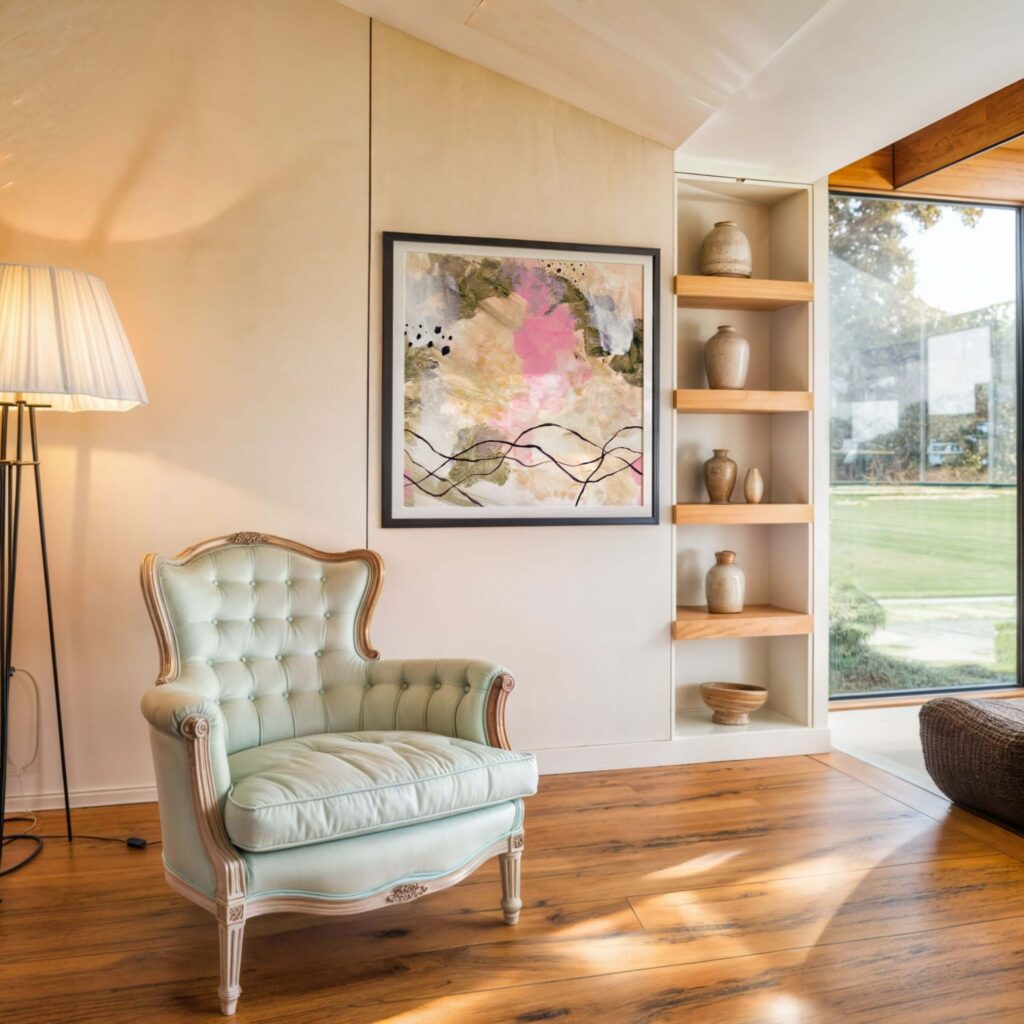
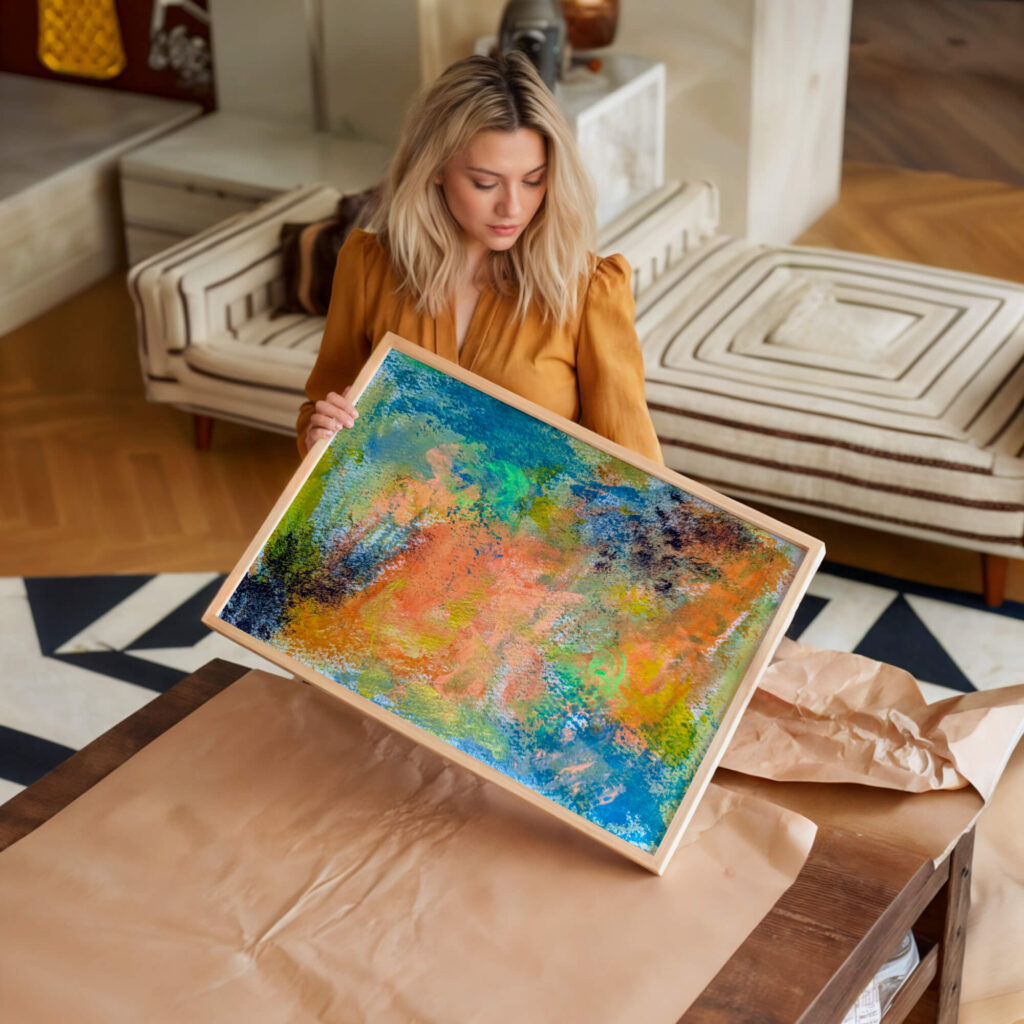
Beyond Trends: Curating for Longevity
Trends are quick. They fill magazines, they circulate through Instagram, and within a year, they’re quietly replaced by something else. If you buy art in that cycle, you end up with walls that feel outdated as quickly as a coffee table book.
Collectors who think long-term approach things differently. They don’t ask, “What’s in right now?” They ask, “What will still matter to me in ten years, when the noise has moved on?” That question changes the kind of work you choose. It pushes you beyond surface aesthetics and into pieces that can hold weight over time.
Longevity in art isn’t about neutrality or safety. It’s not about picking something so bland it could sit in any room without offence. Longevity comes from emotional charge. It’s the work that continues to say something to you, even when the novelty wears off. It grows as you grow, instead of fading as trends shift.
Private catalogues are well-suited to this way of collecting. There’s no seasonal rotation designed to push what’s fashionable. The focus is on resonance, on whether a piece has enough presence to live with for years, not just to be photographed once. That’s what makes a mindful collection feel timeless rather than dated.
In the end, curating for longevity is really curating for yourself. The question isn’t whether a visitor will be impressed today. It’s whether you’ll still find yourself pausing in front of the piece, years from now, and feeling it answer back. That’s the kind of investment worth making.
Conclusion: Collecting Without the Performance
Collecting has always carried a strange double role. On one hand, it’s private, you live with the work, you sit with it, it becomes part of your space. On the other hand, the process of buying is often staged for show. Galleries, fairs, openings: they make collecting feel like a performance.
Private catalogues shift the balance back where it belongs. They strip away the performance and leave you with the work itself. No spotlights, no pressure, no audience. Just you, the art, and the quiet space needed to recognise what holds.
That’s the point of the Collector’s Vault. It isn’t a shop window. It’s a private catalogue, accessible only to those who want to step out of the performance and into something more direct. No trends, no persuasion, no gloss. Just work that was made to last, waiting for the right person to notice it.
If that way of collecting resonates with you, the Vault is there. Quiet, discreet, and designed for those who prefer presence over performance.

